Back in 2018, our neighbors approached us and asked if we’d be interested in buying their 24-acre blueberry farm. Chris and I were so surprised by this unexpected opportunity and had to really stretch outside our comfort zone to make it work.
But ultimately, we decided to go for it because farms in our valley rarely, if ever, go up for sale and we knew we wouldn’t get another chance like this in our lifetime.
Up until this point, we had been farming a 2-acre plot of rented land behind our house and all of our experience and understanding was based on this small footprint. So the prospect of having more land was both exciting and also very daunting.
 From the beginning, I had this overwhelming feeling that our new farm, which at the time was just a wide-open field, was meant to become a place. But beyond that foggy impression, really nothing else about it was clear.
From the beginning, I had this overwhelming feeling that our new farm, which at the time was just a wide-open field, was meant to become a place. But beyond that foggy impression, really nothing else about it was clear.

 Since I’m such a visual person, I have to see something to understand it. And here in the United States, there are very few examples of working farms that incorporate hedgerows, hedges, woodlands, and food for pollinators into a working production model that I could see firsthand.
Since I’m such a visual person, I have to see something to understand it. And here in the United States, there are very few examples of working farms that incorporate hedgerows, hedges, woodlands, and food for pollinators into a working production model that I could see firsthand.
So we decided to take a trip to England and spent 2 glorious weeks touring gardens and farms all around the country looking for inspiration.

 One of our stops on the trip was to visit the famed Chatsworth cutting garden where we met head grower Becky Crowley.
One of our stops on the trip was to visit the famed Chatsworth cutting garden where we met head grower Becky Crowley.
As Becky showed us around the garden, we got to talking about the new farm and all of my dreams for the space. I shared all of the bigger projects that I wanted to include in the new farm’s design, but that I was at a total loss for where to start.
Becky had all of these really wonderful ideas, and to my surprise, had a background as a landscape designer and artist. As we parted ways, I half-jokingly whispered, “You should come to America and help me design the farm!”
I’m still not sure how we were able to pull it off, but we got Becky a visa, and 6 months later, she arrived at Floret.
 While we were waiting for Becky’s visa to be approved, I went to work sourcing as many plants as I possibly could for the project.
While we were waiting for Becky’s visa to be approved, I went to work sourcing as many plants as I possibly could for the project.
Unlike England, where they have an incredible selection of specialty plants readily available, here in the States, many of the family-owned nurseries have gone out of business in the last decade, which has made sourcing plants, especially on such a large scale, very challenging.
My goal was to essentially build an entire nursery to work from so that when Becky arrived we had all of the plants available that she might need and there would be no waiting for plants once the designs were finalized.
Between trees, shrubs, and perennials, I sourced over 40,000 individual plants (from small 50-cell plugs all the way up to balled and burlapped trees) for this project and had a running joke going with our local nursery (which I frequent often) that I was going to become their competition.

 We drew from this bank of plants for nearly 2 years as the farm took shape and I’m so grateful for all of the nurseries that grew such special treasures that are now living here on the farm.
We drew from this bank of plants for nearly 2 years as the farm took shape and I’m so grateful for all of the nurseries that grew such special treasures that are now living here on the farm.
I’ve put together a full list of all the places I sourced plants from for this project. If you’re looking for some really wonderful sources, I highly recommend all of these companies.
 The first thing Becky and I did was to dive deep into all of the hopes and dreams that I had for the space, plus all of the more practical needs that would be required by the farm.
The first thing Becky and I did was to dive deep into all of the hopes and dreams that I had for the space, plus all of the more practical needs that would be required by the farm.
This list included getting water out to the farthest corners of the property, establishing roadways so that vehicles and equipment could have easy access to the growing space, setting aside enough room to store tools and supplies, making sure to include generous turn radiuses so that dump trucks with compost could easily make deliveries … so many essential, but not very exciting details.

 In addition to all of the new spaces I wanted to create such as an orchard, meadow, woodlands, and a more formal cutting garden, the property itself was lacking any kind of structure or privacy.
In addition to all of the new spaces I wanted to create such as an orchard, meadow, woodlands, and a more formal cutting garden, the property itself was lacking any kind of structure or privacy.
Once the blueberries were dug up and given away to local school gardens, parks, and neighbors, the farm was essentially a wide-open exposed field with no trees, no shrubs, and no personality.
When you were standing out in the open field, there was this strange sense of vulnerability, kind of like being a tiny little mouse standing in the middle of a meadow with eagles circling overhead. There was no place to tuck away or hide, and everything felt way too exposed.
 One of the first things we decided on was that we would use hedges and hedgerows to create “living rooms” within the farm to help break the property up into smaller, more intimate spaces.
One of the first things we decided on was that we would use hedges and hedgerows to create “living rooms” within the farm to help break the property up into smaller, more intimate spaces.
Along the outside edges of all of our growing blocks, we planted a series of different hedgerow plant combinations to test out which varieties were most suitable for our climate and needs.

 By definition, a hedgerow is a mixed planting of shrubs and small trees that grows together to become a living wall. These plantings have many benefits, but some of the most important are that they help to slow down the wind and prevent erosion and damage to field crops and provide a nectar source for pollinators and food and shelter for songbirds.
By definition, a hedgerow is a mixed planting of shrubs and small trees that grows together to become a living wall. These plantings have many benefits, but some of the most important are that they help to slow down the wind and prevent erosion and damage to field crops and provide a nectar source for pollinators and food and shelter for songbirds.
I’ve heard hedgerows described as a living corridor for wildlife, helping them safely travel from one place to another.

 Along the far back edge of the property we planted a large L-shaped hedgerow filled with native plants and as you move closer to the central hub of the farm, each series of hedgerows becomes more ornamental and less wild and scruffy.
Along the far back edge of the property we planted a large L-shaped hedgerow filled with native plants and as you move closer to the central hub of the farm, each series of hedgerows becomes more ornamental and less wild and scruffy.
In addition to planting hedgerows along our field blocks, we also planted both evergreen and deciduous single-species hedges around some of the gardens. Unlike the hedgerows that are meant to create a beautiful tangle of life, these single-species hedges are quite different in appearance and in overall growth habit. This type of hedge is traditionally pruned to maintain a neat and tidy appearance.
 If you want to learn more about the hedgerow plantings, what we’ve learned so far, and the varieties we used, be sure to read the Hedges & Hedgerows resource.
If you want to learn more about the hedgerow plantings, what we’ve learned so far, and the varieties we used, be sure to read the Hedges & Hedgerows resource.
 One of the other big goals I had was to attract as many pollinators to our farm as possible. During the summer months when our flower fields are in full bloom, there is an abundance of food available, but during the spring months and into autumn the pollen and nectar sources are scarce.
One of the other big goals I had was to attract as many pollinators to our farm as possible. During the summer months when our flower fields are in full bloom, there is an abundance of food available, but during the spring months and into autumn the pollen and nectar sources are scarce.
After spending a good deal of time researching the perennials that are most attractive to pollinators, Becky went to work designing a series of pollinator strips. These are beautifully curated collections of perennials planted in larger, more naturalistic swaths, which provide a food source for wildlife along the edges of our growing fields.
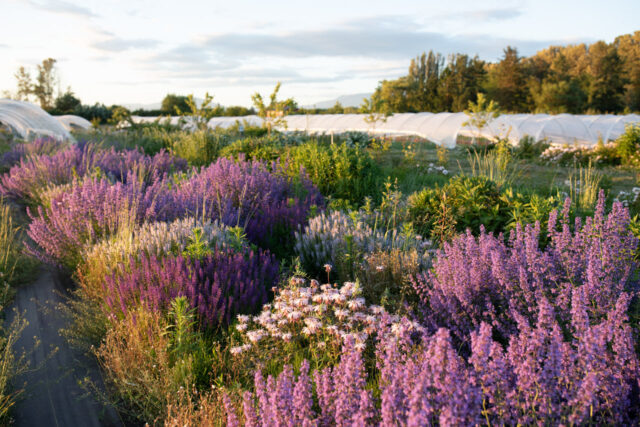
 If you want to learn more about this beautiful experiment, be sure to read our Pollinator Strips resource. It includes a printable set of planting plans if you’re interested in creating one of your own.
If you want to learn more about this beautiful experiment, be sure to read our Pollinator Strips resource. It includes a printable set of planting plans if you’re interested in creating one of your own.
 When we moved to the country about 20 years ago, I planted an orchard filled with heirloom apple trees in hopes of one day starting a cider business. But as my flower hobby grew and I ran out of space, I ended up having to dig up my sweet little orchard to make room for my first seed-starting greenhouse.
When we moved to the country about 20 years ago, I planted an orchard filled with heirloom apple trees in hopes of one day starting a cider business. But as my flower hobby grew and I ran out of space, I ended up having to dig up my sweet little orchard to make room for my first seed-starting greenhouse.
I always felt sad about making that decision, but there was not enough room to have both in our backyard. Finally, all these years later, the big farm had room to plant a new orchard and I was able to replace all of the trees that I had given away, plus many more.
 Our new orchard now includes heirloom cider apples, cooking apples, crabapples, pears, plums, quince, and cherry trees. Last summer was our first real harvest and I found myself out there every day hunting for ripe fruit. The orchard is hands down Chris’s favorite spot on the farm and he’s always filling his pockets with snacks.
Our new orchard now includes heirloom cider apples, cooking apples, crabapples, pears, plums, quince, and cherry trees. Last summer was our first real harvest and I found myself out there every day hunting for ripe fruit. The orchard is hands down Chris’s favorite spot on the farm and he’s always filling his pockets with snacks.
One of my very favorite things we did in the orchard was to transplant all of our daffodils and narcissus into the grass pathways. In the spring when the trees are in full flower, the daffodils form a carpet of blooms at their feet.

 The Skagit Valley was once completely forested, and around the turn of the century, the whole area was logged so that the rich soil could be farmed. While this land is some of the finest growing ground in the country, I’ve always wanted to return a portion of our land back to forest.
The Skagit Valley was once completely forested, and around the turn of the century, the whole area was logged so that the rich soil could be farmed. While this land is some of the finest growing ground in the country, I’ve always wanted to return a portion of our land back to forest.
 At the very back corner of the farm, there is a low spot where water collects in the spring, and once the puddle fills and the frogs start laying their eggs, there is a chorus of frog songs every evening.
At the very back corner of the farm, there is a low spot where water collects in the spring, and once the puddle fills and the frogs start laying their eggs, there is a chorus of frog songs every evening.
The tadpole puddle, as my kids call it, is bordered by a large field that we designated as a woodland. It is filled with maples, liquidambar, zelkova, hazelnuts, crabapples, and London planes.

 As we wait for these trees to mature, we’ve planted a meadow all around them filled with a mixture of grasses and wildflowers, including daisies, lupine, clover, sainfoin, and yarrow. Of all the places on the farm, this spot is the most wild and unstructured and it’s where I find myself retreating.
As we wait for these trees to mature, we’ve planted a meadow all around them filled with a mixture of grasses and wildflowers, including daisies, lupine, clover, sainfoin, and yarrow. Of all the places on the farm, this spot is the most wild and unstructured and it’s where I find myself retreating.
On particularly difficult days, there is something incredibly calming about sitting in a field of tall grass and watching it blow in the breeze that somehow makes the stress of the day melt away.

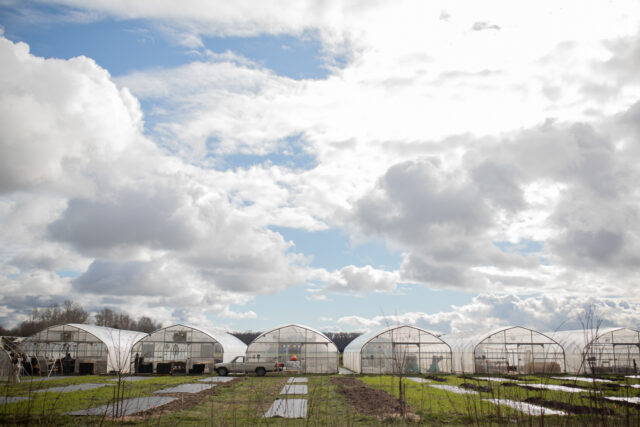 One of the biggest lessons that I learned when we set up our original little farm was to situate the highest maintenance/most used spaces as close to the main hub of activity as possible. So when it came time to build our new greenhouses, we decided to construct them next to the barn.
One of the biggest lessons that I learned when we set up our original little farm was to situate the highest maintenance/most used spaces as close to the main hub of activity as possible. So when it came time to build our new greenhouses, we decided to construct them next to the barn.
This way we would have easy access to the restroom, water, and all of the tools and supplies that are stored inside.
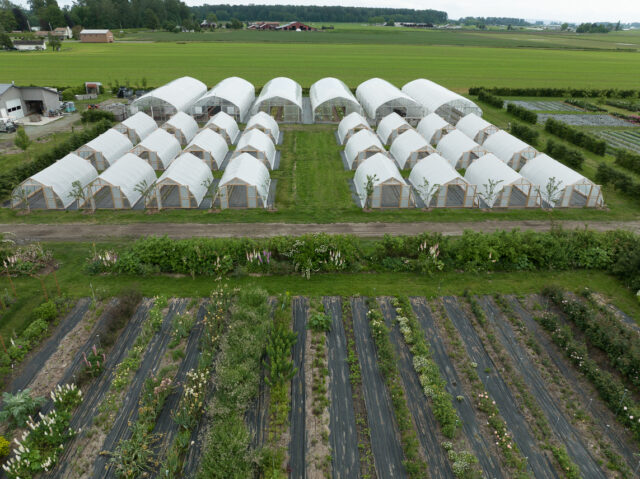 As my flower breeding hobby has turned into a full-time endeavor, we’ve added a series of smaller hoop houses that are used as individual isolation spaces to develop new flower varieties.
As my flower breeding hobby has turned into a full-time endeavor, we’ve added a series of smaller hoop houses that are used as individual isolation spaces to develop new flower varieties.
This fleet of 24 little hoops has been lovingly nicknamed the Shire because their unique gothic shape reminds me of little hobbit houses. These structures were purchased from Farmers Friend and I can’t recommend this company highly enough.

 Across the road from the Shire is our original farm site, which hasn’t changed much over the years in terms of bed layout, but the plants inside have shifted into more perennials (which we’re trialing for cutting) and is now the home of part of our rose collection.
Across the road from the Shire is our original farm site, which hasn’t changed much over the years in terms of bed layout, but the plants inside have shifted into more perennials (which we’re trialing for cutting) and is now the home of part of our rose collection.

 One of the most beautiful additions that we made to this space was to have a series of custom metal archways created by Metalistics, a local fabrication shop. These beautiful arbors line the central pathways and are connected in the middle by a glorious arching structure which will eventually be covered in rambling roses.
One of the most beautiful additions that we made to this space was to have a series of custom metal archways created by Metalistics, a local fabrication shop. These beautiful arbors line the central pathways and are connected in the middle by a glorious arching structure which will eventually be covered in rambling roses.
Along the other roadway is a series of tall metal pillars that will also have climbing roses growing up through the middle and cascading over the tops. The idea is that they will resemble fountains of flowers.
 For many years our backyard housed the business, including six greenhouses, my little flower studio, and a walk-in cooler. The new farm allowed us to finally move the business and reclaim the space as our own.
For many years our backyard housed the business, including six greenhouses, my little flower studio, and a walk-in cooler. The new farm allowed us to finally move the business and reclaim the space as our own.
Of all the design projects that we tackled in the nearly 2 years that Becky was here with us, she felt this project was one of the most important. After so many years of not having any privacy, I could finally stretch out and have my own little sanctuary.
 In every other planting we tackled on the farm, we chose small 1-gallon plants and bare root trees and shrubs. This approach made planting on such a large scale much more affordable but added a number of years to the property filling in.
In every other planting we tackled on the farm, we chose small 1-gallon plants and bare root trees and shrubs. This approach made planting on such a large scale much more affordable but added a number of years to the property filling in.
However, in our home garden, we decided to do the opposite and worked with a local family-owned nursery that specializes in growing and installing nearly mature trees and shrubs.
The owner Terry Wiggins, one of the most solid guys around, jokes that his business is all about giving people the gift of time. Wiggin’s Nursery Co. has perfected the art of growing and transplanting specimen trees and shrubs that allow gardeners to have a fully mature garden installed in just a matter of days.

 We worked closely with their team on selecting a beautiful collection of plants, and over a long weekend, their hard-working crew installed the bones of our new garden.
We worked closely with their team on selecting a beautiful collection of plants, and over a long weekend, their hard-working crew installed the bones of our new garden.
In the beginning, I felt a bit nervous about making such an investment in our space, but of all the things that we tackled, our home garden is my very favorite. Becky was right.

 While we made a tremendous amount of progress on the farm in the last couple of years, there’s still a lot that I want to do.
While we made a tremendous amount of progress on the farm in the last couple of years, there’s still a lot that I want to do.
Now that the bones of the space are starting to fill in, the farm is finally starting to really feel like a place.

 The next big project on the docket is figuring out where all of the roses that we’ve adopted from The Friends of Vintage Roses and Anne Belovich’s garden will live. In all, there are more than 2,200 roses now here on the farm and I am excited about all of the beauty to come.
The next big project on the docket is figuring out where all of the roses that we’ve adopted from The Friends of Vintage Roses and Anne Belovich’s garden will live. In all, there are more than 2,200 roses now here on the farm and I am excited about all of the beauty to come.
You can read about our progress in this Rose Project Update.
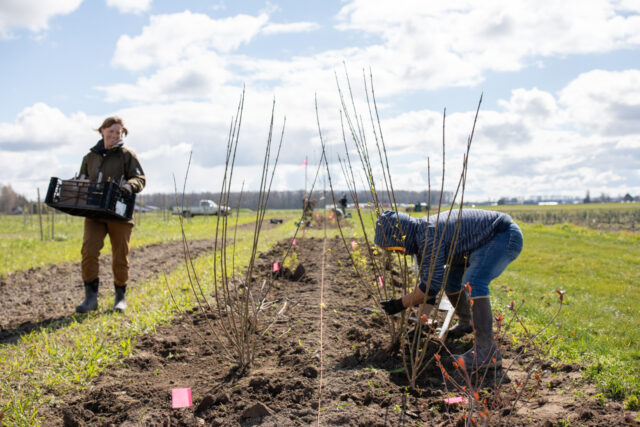
 Lastly, a huge thank you to Becky Crowley for her incredible design and for humoring me with all of the many dreams and hopes I wanted to squeeze into this place. This project never would have happened without her talent or heart!
Lastly, a huge thank you to Becky Crowley for her incredible design and for humoring me with all of the many dreams and hopes I wanted to squeeze into this place. This project never would have happened without her talent or heart!
And so much gratitude for our crew (especially Francisco) for the years of work they have invested in the transformation of this place, from planting thousands of baby plants in the ground to tending them in every type of weather to mulching, weeding, and pruning—what a feat!
Please note: If your comment doesn’t show up right away, sit tight; we have a spam filter that requires us to approve comments before they are published.






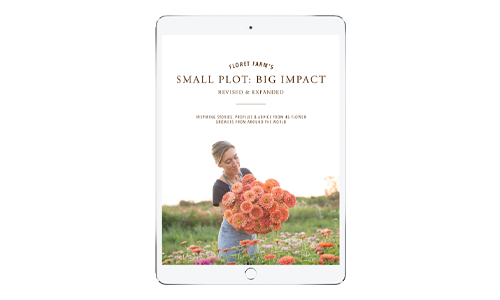
Kathy Ormiston on
Home with Covid, so I just watched the first season of Growing Floret. I loved the last episode with Becky Crowley. It would be so interesting to see an update on how the design for the farm has filled in and evolved. It has given me ideas for my own garden/farm backyard in Davis, California.